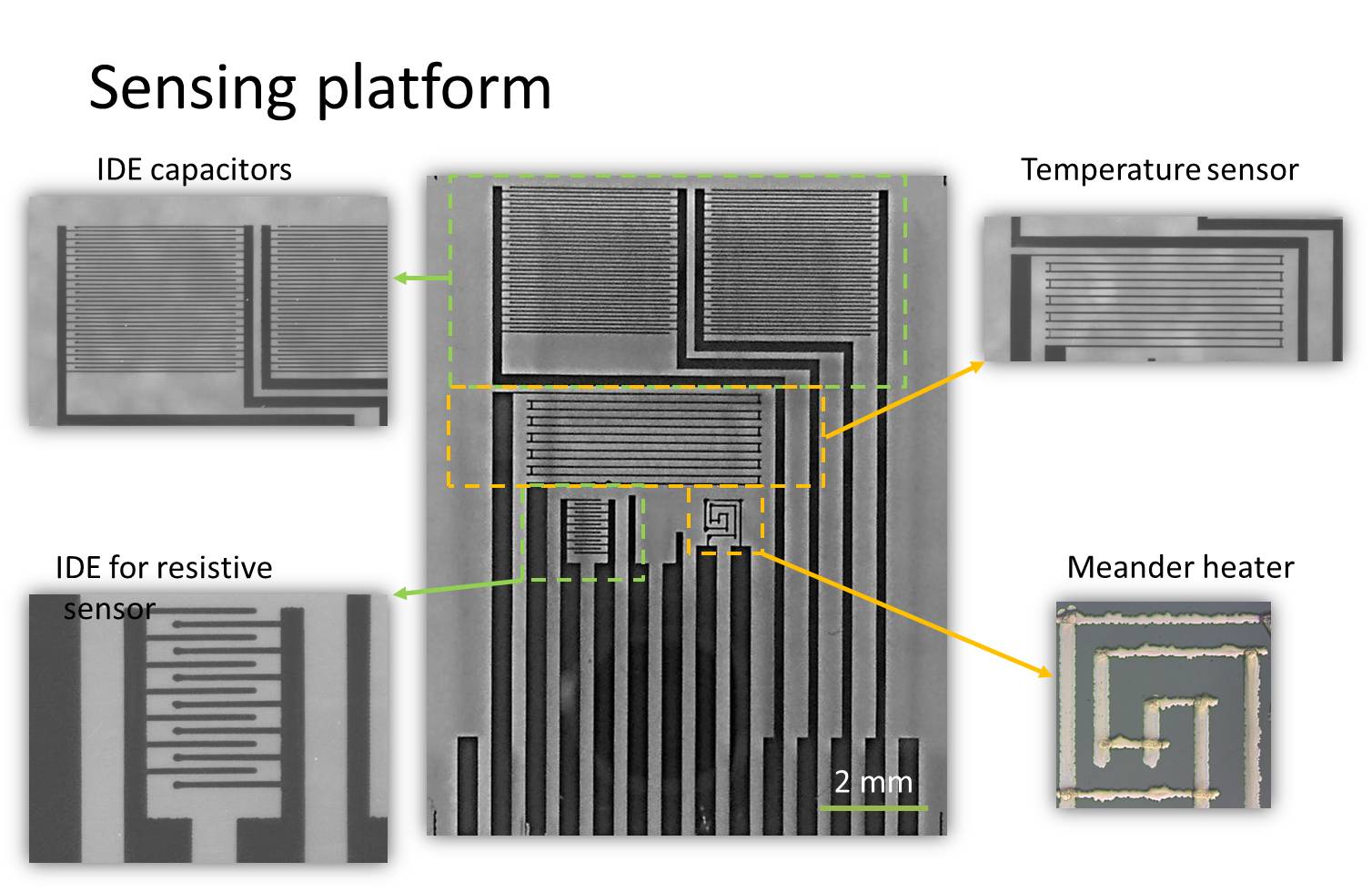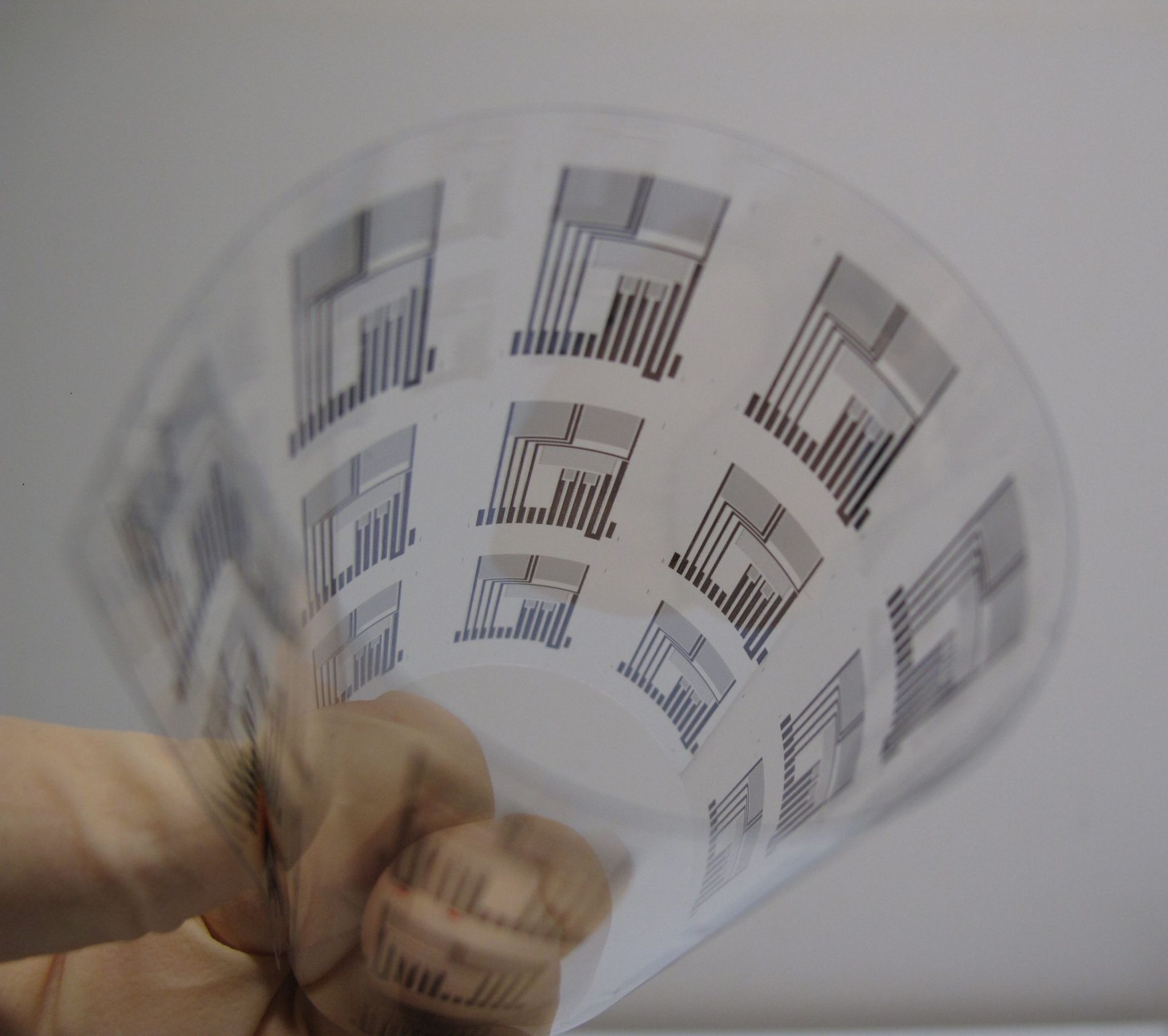The goal of the FlexSmell project is to produce a hybrid (organic-inorganic) very low-cost, ultra low-power olfaction system. This system is based on sensing polymers and bio-receptors, and implemented on a flexible substrate using printing techniques. Different transduction principles such as field-effect, resistive and capacitive have been implemented to achieve a good trade-off between low power consumption and selectivity. Methods for the functionalization and integration of these devices as well as their encapsulation have been addressed to form multi-sensing platforms at very low-cost. A hybrid approach is being developed to assemble the sensors with flexible silicon electronics components to realize passive and semi-active smart sensing RFID label. The demonstration of the project includes a prototype of an ultra-low-power smart chemical sensing RFID label for food freshness & quality traceability control through smart packaging.
At LMTS-EnviroMEMS we have been focusing on the realization of printed ultra-low power chemical gas sensors on flexible substrates. Capacitive sensors based on different architectures have been fabricated by means of printing. We have been optimizing performances and minimizing sensors area passing from an interdigitated electrode to a parallel plate structure. Capacitive gas sensors fabricated on PET substrate using ink-jet printing were realized successfully. Thanks to its digital character, ink-jet printing enables the functionalization of transducers with different sensing layers for the formation of gas sensor arrays. Furthermore, we have included inkjet-printed / electroplated thermoresistors in our systems to compensate for temperature changes during gas sensing measurements. Finally, we have been working on large area compatible encapsulation techniques for these sensors based on the lamination of a gas permeable membrane.
These capacitive and RTD sensors have been co-integrated with conducting polymers gas sensors onto a multi-sensor platform. This multi-sensor platform is now being interfaced to the printed smart RFID label using low-temperature assembly procedures for its validation.
Recently, we have demonstrated fully printed metal-oxide gas sensors on polyimide foil, heater, electrodes, dielectric and sensing layers were printed.
|
Flexible Multi-Sensor Array Fabricated on Polymeric Foil |
Scientific publications
S. Khan, D. Briand, All-printed low-power metal oxide gas sensors on polymeric substrates, Flexible and Printed Electronics, 4 (2019) 015002.
R. Zhou, J. Lia, H. Jiang, H. Lia, Y. Wang, D. Briand, M. Camara, G. Zhou, N. F. de Rooij, Highly transparent humidity sensor with thin cellulose acetate butyrate and hydrophobic AF1600X vapor permeating layers fabricated by screen printing, Sensors & Actuators: B. Chemical, 281 (2019) 212–220.
C. Willa, A. Schmid, D. Briand, J. Yuan, D. Koziej, Lightweight, Room temperature CO2 gas sensor based on rare-earth metal free composites – An impedance study, ACS Applied Materials & Interfaces, 9(30) (2017) 25553-25558.
M. Rieu, M. Camara, G. Tournier, J.-P. Viricelle, C. Pijolat, N.F. de Rooij, D. Briand, Fully inkjet printed SnO2 gas sensor on plastic substrate, Sensors and Actuators B 236 (2016) 1091-1097.
F. Molina-Lopez, D. Briand, N.F. de Rooij, Inkjet and microcontact printing of functional materials on foil for the fabrication of pixel-like capacitive vapor microsensors, Organic Electronics, 16 (2015) 139-147.
E. Danesh, F. Molina Lopez, Malick Camara, Alexia Bontempi, Andrés Vásquez Quintero, Damien Teyssieux, Laurent Thiery, D. Briand, N.F. de Rooij, K. Persaud, Development of a new generation of ammonia sensors on printed polymeric hotplates, Analytical Chemistry, 86 (2014) 8951-8958.
F. Molina-Lopez, A. Vásquez Quintero, G. Mattana, D. Briand and N. F. de Rooij, “Large-area compatible fabrication and encapsulation of inkjet-printed humidity sensors on flexible foils with integrated thermal compensation”, J. Micromech. Microeng., vol. 23 (2013), pp. 025012.
F. Molina-Lopez, D. Briand, N.F. de Rooij, “Decreasing the size of printed comb electrodes by the introduction of a dielectric interlayer for capacitive gas sensors on polymeric foil: Modeling and fabrication”, Sensors and Actuators B: Chemical (2013), DOI: 10.1016/j.snb.2013.01.008.
F. Molina-Lopez, D. Briand, N.F. de Rooij, “All additive inkjet printed humidity sensors on plastic substrate”, Sensors and Actuators B: Chemical, vol. 166-167 (2012), pp. 212-222.
Contact person: Danick Briand

